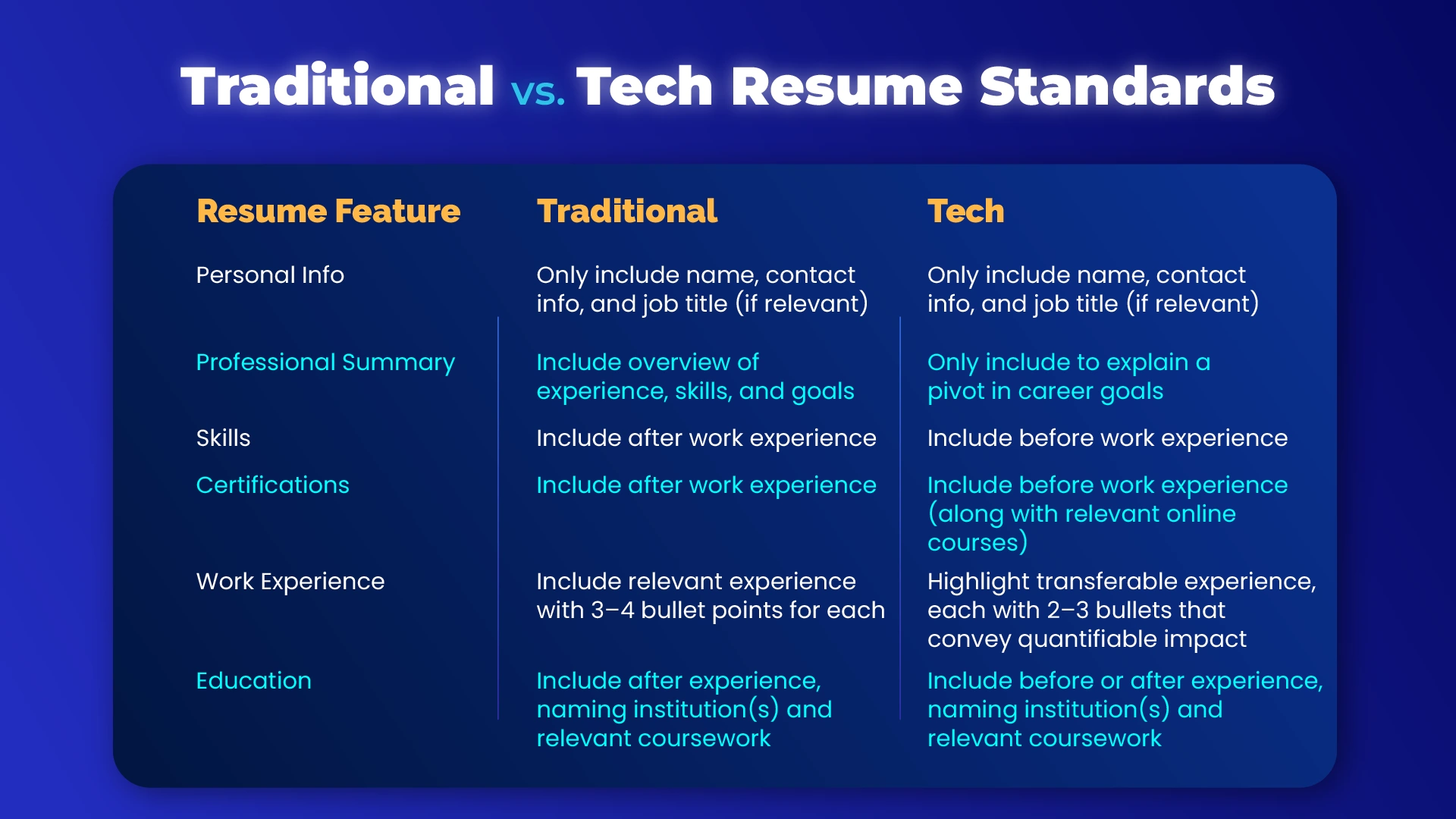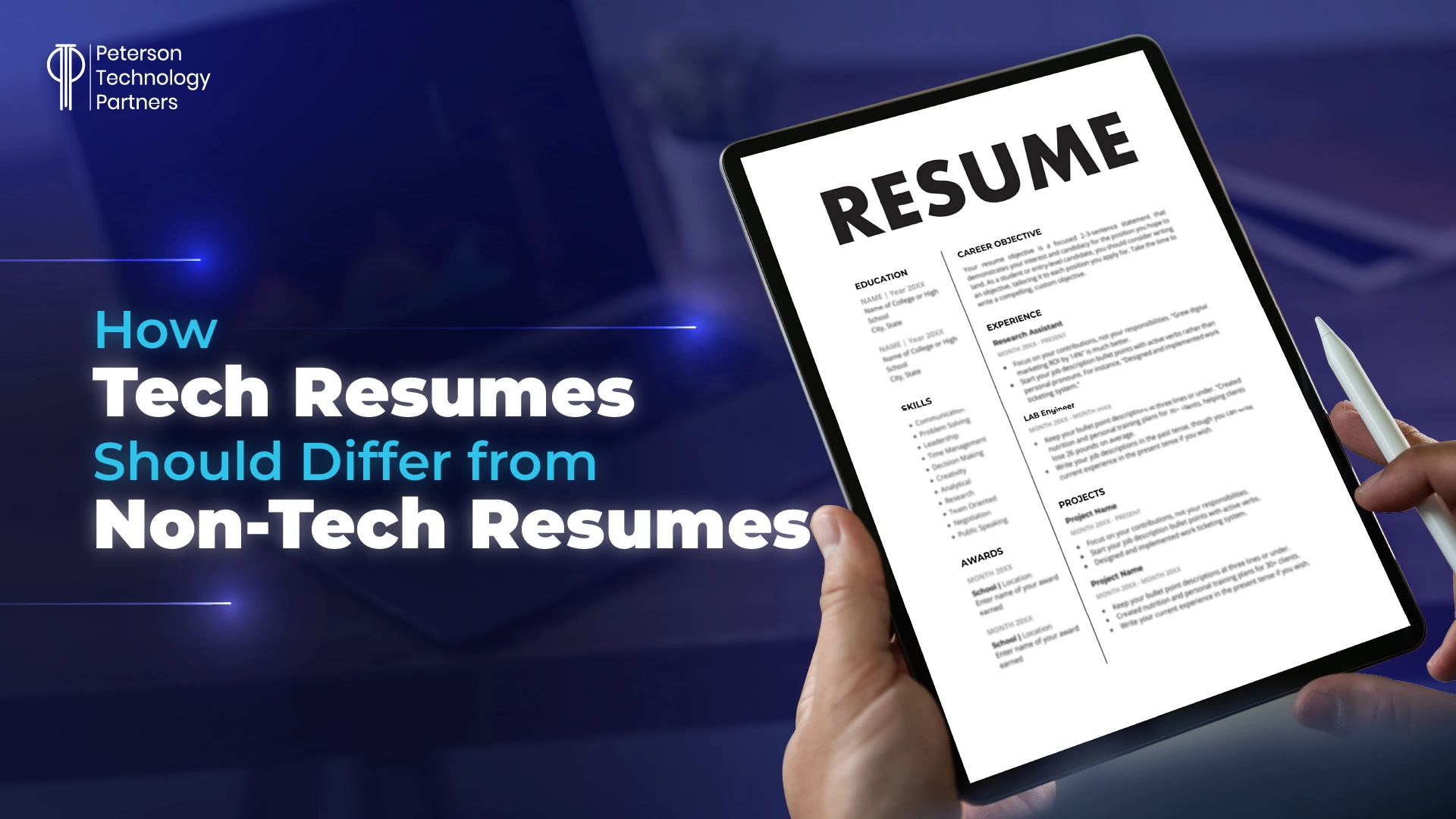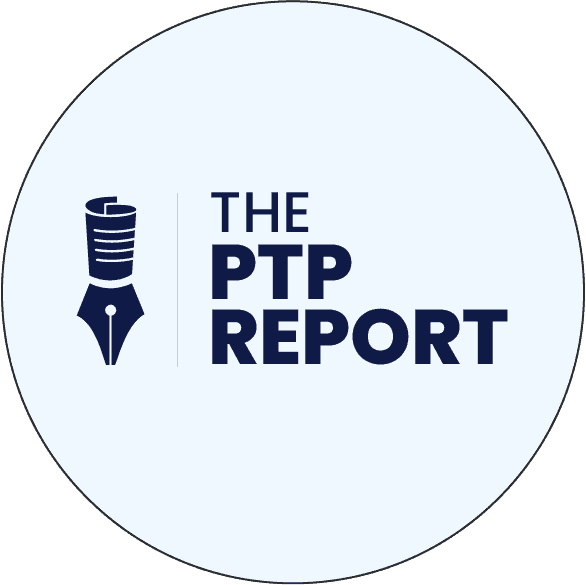Introduction
Some resume tips have transcended industry and time—like using strong action verbs to describe your work experience and only including recent and relevant work history. But if you’re crafting a tech resume, there are some key differences you’ll need to be aware of.
Whether you’re pivoting into tech or simply want to stay up to date on tech resume standards, this article is for you.
Why Pivot to Tech Now?
You might be wondering, “Is a career pivot into tech the best move considering all the headlines about layoffs?” It’s a fair concern. In fact, many industry leaders say entry-level tech jobs are in trouble (like Anthropic’s CEO), since more and more typical entry-level tasks can be performed by AI.
[Check out this recent article by PTP CEO Nick Shah on the AI jobs impact for more on this topic.]
That said, no matter how advanced AI gets, organizations will likely still need people who can:
- Engineer and improve AI models
- Protect companies from evolving cybersecurity threats AI might create
- Ensure AI compliance and data privacy
- Leverage AI to improve functions like business intelligence and software development
We’re not saying it is easy to make a pivot, but it is attainable, especially if you highlight transferable skills, pursue online courses and certifications, and make connections in the tech industry.
That said, none of these methods will be very effective if your resume isn’t up to tech industry standards.
[Which IT jobs are safe from AI? Find out in this PTP Report.]

Tech Resumes by Layout
Let’s explore the unique standards of tech resumes, from top to bottom.
Personal Information
You’ll likely include the same personal information in a tech resume that you would a traditional resume: full name, personal pronouns, email, phone number, city.
The key is to keep it from taking up a lot of space on your resume, which is where savvy formatting comes in. For example, you can save precious space by including this information in a heading as opposed to the start of the document body. Just make sure your formatting isn’t too fancy, or else your resume will be hard to read, both by humans and AI.
Professional Summary
A non-technical resume may include a paragraph about who you are as a professional, including a summary of your work experience and career goals. For tech professionals, however, you’ll want this section to be shorter. You may opt not to include it altogether.
In a tech resume, a professional summary should be no longer than two–three sentences, every detail of which is necessary for the hiring manager to know. This would be a good place for less experienced candidates to mention their career goals and willingness to learn.
Another consideration is to refrain from using overly technical jargon in your professional summary, as those reading it will likely be HR professionals, not fellow techies. Besides, you’ll have a chance to include such keywords in your skills section.
Skills
Unlike a traditional resume, a tech resume places a huge emphasis on skills, both hard and soft, which is why they should be featured prominently before your work experience.
However, this means you need to be extra mindful about which skills you include. As more job seekers are aware of AI use in resume screening, many feel the pressure to include any keyword that might stand out to an ATS. But you don’t want to stuff your resume with redundant skills that are not tailored to the job you’re applying for.
Make sure to include any skill you possess that appears in the job description, especially technical proficiencies like programming languages, cybersecurity frameworks, and development methodologies, though you don’t need to reiterate any skills that are covered in your certifications listed.
Certifications
Certifications play a large role in the tech job market, as they validate proficiencies in very specific, hard skills—i.e., using specific programming languages, creating algorithms, testing software security.
For this reason, certifications should be featured toward the top of your resume, before work experience. Just make sure the certifications are both up to date and relevant to the role you’re applying for. (You wouldn’t include your CPR certification in a cybersecurity role, right?)
[Learn which AI certifications will land you the best roles in this PTP Report.]
Work Experience
Like traditional resumes, tech resumes should list relevant work experience in reverse chronological order.
However, in traditional resumes, you’ll typically include four to five bullet points describing your contributions, while tech resumes are all about being to-the-point. You should be able to convey your experience in two to three bullet points.
These points should concisely communicate the quantifiable impact you had in your role and/or any skills you honed at the role that appear in the job description.
[For specific advice on how to quantify your tech resume, read this PTP Report.]
Education
The placement of your education section might be a judgment call. If you have a degree from an Ivy League school, a relevant master’s degree, or if your coursework was particularly relevant to the job, then you may want to feature that toward the top of your resume. If not, then it can follow work experience like most resumes typically do.
Personal Projects
Some tech professionals recommend listing your personal projects in a similar way to work experience, just at the bottom of your resume—naming the project, describing its purpose and how you executed it, and what tools you used to complete it, then linking to a portfolio.
Others say the link alone is sufficient and saves space. A solution that leverages the best of both worlds is to keep the project descriptions in the link, featured alongside the projects.
Conclusion
While this tech resume guide reflects the industry standard today, it isn’t necessarily Bible. You have to put yourself in the shoes of both hiring managers and AI when editing your resume, asking yourself, “Is it clear? Relevant? To the point?” When in doubt, assume whoever is reading your resume (other than AI) is a person with modest technical expertise and a short attention span.
Once you feel confident with your tech resume, be sure to explore which jobs are out there. You can browse PTP’s job board, or you can upload your resume to our website and get matched by one of our expert recruiters!
FAQs
What resume format (chronological, functional, or combination) is best for professionals pivoting into tech?
The combination format is best for those pivoting into tech, because they have work experience to highlight, but it may not reveal their relevant technical skillset as much as skills and certifications will. This combination format features skills and certifications before work experience but still lists work experience in reverse chronological order, highlighting transferable skills.
How should I list my soft skills on my resume as someone pivoting into tech?
Soft skills are rising in importance in the tech industry due to its rapidly changing nature, making adaptability, problem-solving, communication, and critical thinking some of the top in-demand skills. However, if you’re a tech newbie, you must be careful about keyword stuffing soft skills, as it may come across as overcompensating for a lack of hard skills. Rather than listing all of your soft skills in your skills section, pepper some into your work experience and professional summary if you have one.
How can I quantify my tech resume without much tech experience?
Consider highlighting experience related to transferable soft skills. If you are including a leadership position on your resume, for example, quantify your impact by listing how many people you led, how many projects you successfully spearheaded, how much time or money you were able to save, etc.





